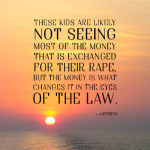Before, I never thought about sex trafficking happening here—not in the United States. The extent of my knowledge about this seedy issue revolved around the 2008 film “Taken,” and just in case I ever needed to be rescued, I was hoping that my dad had a special set of skills like Liam Neeson.
Fast-forward to college, when I became aware of how sex was used historically in wars, conquests, to assert dominance, and to physically and psychologically destroy communities. Finally, in graduate school, I learned that it was not only happening in the US, but it was happening in Connecticut. In May 2011, Vanity Fair published an article, “Sex Trafficking of Americans: The Girls Next Door”, which explored the growing problem of sex trafficking and exploitation of women and children in the US, specifically on the Turnpike (as it is known by us native Central Connecticans).
I had spent my childhood on that Turnpike going to Chuck E. Cheese’s, bowling, go kart racing, and miniature golfing, and I always saw it as place of innocence. Well, until I came across this article and subsequently the book “The Berlin Turnpike: A True Story of Human Trafficking in America.” My childhood memories were quickly darkened by this shadow of deceit. Sex trafficking and exploitation infiltrated my world, and even in my newfound knowledge of what was happening just down the street, I still couldn’t fathom it. It somehow existed in a time and place where I was not—somewhere far and foreign—and as far removed from my Turnpike as possible.
Soon, I let it go… forgot… or ignored what was happening, until I read about it again, and this time I would remember, “First Nations Women are Being Sold into the Sex Trade on Ships along Lake Superior.” I wasn’t the little girl looking to be rescued by daddy anymore; I wasn’t just reading materials to cite in research papers; I was a woman on my own, in touch with my identity, and the injustices of women from every ethnicity and every socioeconomic background.
University of Minnesota graduate student Christina Stark started research on the trafficking of Native Women in Minnesota, which led her down a rabbit hole to other stories of women, children and even babies exploited for commercial sex from the harbors of Thunder Bay in Ontario, Canada to Duluth, Minnesota. These women weren’t foreigners. They were indigenous people. Prostitution was introduced to Native Americans with colonialism, prior to which their culture held them as sacred.

Photo from the Star Tribune of the Duluth Harbor
The quotes alone from these women are haunting: “Women like myself need someone they feel they can trust without being judged by how they lived their life. We didn’t wake up and choose to become a whore or a hooker or a ‘ho’ as they call us. We need someone to understand where we came from and how we lived and that half of us were raped, beat, and made to sell our bodies. We need people with hearts.” Another women said, ““After you get into prostitution, you get used to it; it’s like using the bathroom. You don’t think about it after a while, it takes all your feeling of being a woman away.” For these women, their cultural identity was everything. Stark found that the majority owed their survival to Native cultural practices.
The stories that Stark collected directly reflected the historical degradation and abuse of native women. The historical patterns of settler-colonialism, sex as a war tactic, and the “submissive Indian maiden” mythology—the reason many of these women and children are sought in the first place and made to perform during forced intercourse—outraged me. Who was stopping this? The root of sex trafficking goes beyond the buyer and seller, and forces us to explore the impact of poverty, homelessness, alcoholism, and abuse (all forms of it). Based on the 2010 census, we know that American Indians (including Alaskan Natives) are disproportionately impoverished in comparison to the rest of the US and similar to the stories heard on the Berlin Turnpike; money, drugs, and intimidation are consistently used to coerce these women and keep them in a cycle of trafficking.
Fortunately now, we are collecting more data and garnering the statistics associated with this allusive world. Sex trafficking isn’t just a third-world issue; it is a first-world problem happening in our communities across this nation. Awareness is the first step, but action is the next step we must take to help put an end to this epidemic. Together, we can stop the violence happening to women and restore hope for our future! Today, I’d like you to take this phrase: I will be the change. Now, write it down, say it aloud to seven others, and do it. Visit New Friends New Life, and find out how you can get involved with agencies in your community.
Be the change!
Bu






